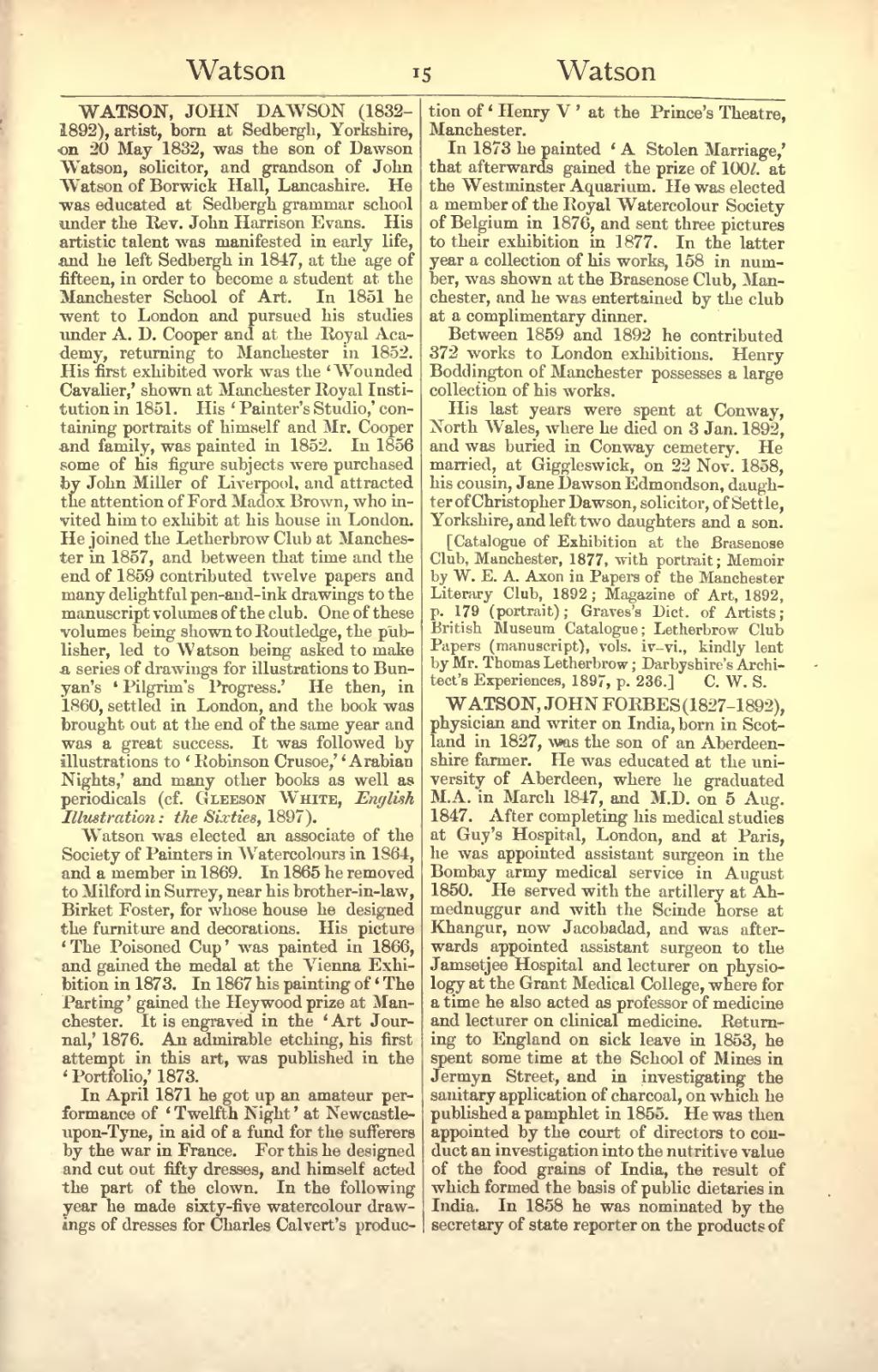WATSON, JOHN DAWSON (1832–1892), artist, born at Sedbergh, Yorkshire, on 20 May 1832, was the son of Dawson Watson, solicitor, and grandson of John Watson of Borwick Hall, Lancashire. He was educated at Sedbergh grammar school under the Rev. John Harrison Evans. His artistic talent was manifested in early life, and he left Sedbergh in 1847, at the age of fifteen, in order to become a student at the Manchester School of Art. In 1851 he went to London and pursued his studies under A. D. Cooper and at the Royal Academy, returning to Manchester in 1852. His first exhibited work was the ‘Wounded Cavalier,’ shown at Manchester Royal Institution in 1851. His ‘Painter's Studio,’ containing portraits of himself and Mr. Cooper and family, was painted in 1852. In 1856 some of his figure subjects were purchased by John Miller of Liverpool, and attracted the attention of Ford Madox Brown, who invited him to exhibit at his house in London. He joined the Letherbrow Club at Manchester in 1857, and between that time and the end of 1859 contributed twelve papers and many delightful pen-and-ink drawings to the manuscript volumes of the club. One of these volumes being shown to Routledge, the publisher, led to Watson being asked to make a series of drawings for illustrations to Bunyan's ‘Pilgrim's Progress.’ He then, in 1860, settled in London, and the book was brought out at the end of the same year and was a great success. It was followed by illustrations to ‘Robinson Crusoe,’ ‘Arabian Nights,’ and many other books as well as periodicals (cf. Gleeson White, English Illustration: the Sixties, 1897).
Watson was elected an associate of the Society of Painters in Watercolours in 1864, and a member in 1869. In 1865 he removed to Milford in Surrey, near his brother-in-law, Birket Foster, for whose house he designed the furniture and decorations. His picture ‘The Poisoned Cup’ was painted in 1866, and gained the medal at the Vienna Exhibition in 1873. In 1867 his painting of ‘The Parting’ gained the Heywood prize at Manchester. It is engraved in the ‘Art Journal,’ 1876. An admirable etching, his first attempt in this art, was published in the ‘Portfolio,’ 1873.
In April 1871 he got up an amateur performance of ‘Twelfth Night’ at Newcastle-upon-Tyne, in aid of a fund for the sufferers by the war in France. For this he designed and cut out fifty dresses, and himself acted the part of the clown. In the following year he made sixty-five watercolour drawings of dresses for Charles Calvert's production of ‘Henry V’ at the Prince's Theatre, Manchester.
In 1873 he painted ‘A Stolen Marriage,’ that afterwards gained the prize of 100l. at the Westminster Aquarium. He was elected a member of the Royal Watercolour Society of Belgium in 1876, and sent three pictures to their exhibition in 1877. In the latter year a collection of his works, 158 in number, was shown at the Brasenose Club, Manchester, and he was entertained by the club at a complimentary dinner.
Between 1859 and 1892 he contributed 372 works to London exhibitions. Henry Boddington of Manchester possesses a large collection of his works.
His last years were spent at Conway, North Wales, where he died on 3 Jan. 1892, and was buried in Conway cemetery. He married, at Giggleswick, on 22 Nov. 1858, his cousin, Jane Dawson Edmondson, daughter of Christopher Dawson, solicitor, of Settle, Yorkshire, and left two daughters and a son.
[Catalogue of Exhibition at the Brasenose Club, Manchester, 1877, with portrait; Memoir by W. E. A. Axon in Papers of the Manchester Literary Club, 1892; Magazine of Art, 1892, p. 179 (portrait); Graves's Dict. of Artists; British Museum Catalogue; Letherbrow Club Papers (manuscript), vols. iv–vi., kindly lent by Mr. Thomas Letherbrow; Darbyshire's Architect's Experiences, 1897, p. 236.]
WATSON, JOHN FORBES (1827–1892), physician and writer on India, born in Scotland in 1827, was the son of an Aberdeenshire farmer. He was educated at the university of Aberdeen, where he graduated M.A. in March 1847, and M.D. on 5 Aug. 1847. After completing his medical studies at Guy's Hospital, London, and at Paris, he was appointed assistant surgeon in the Bombay army medical service in August 1850. He served with the artillery at Ahmednuggur and with the Scinde horse at Khangur, now Jacobadad, and was afterwards appointed assistant surgeon to the Jamsetjee Hospital and lecturer on physiology at the Grant Medical College, where for a time he also acted as professor of medicine and lecturer on clinical medicine. Returning to England on sick leave in 1853, he spent some time at the School of Mines in Jermyn Street, and in investigating the sanitary application of charcoal, on which he published a pamphlet in 1855. He was then appointed by the court of directors to conduct an investigation into the nutritive value of the food grains of India, the result of which formed the basis of public dietaries in India. In 1858 he was nominated by the secretary of state reporter on the products of
